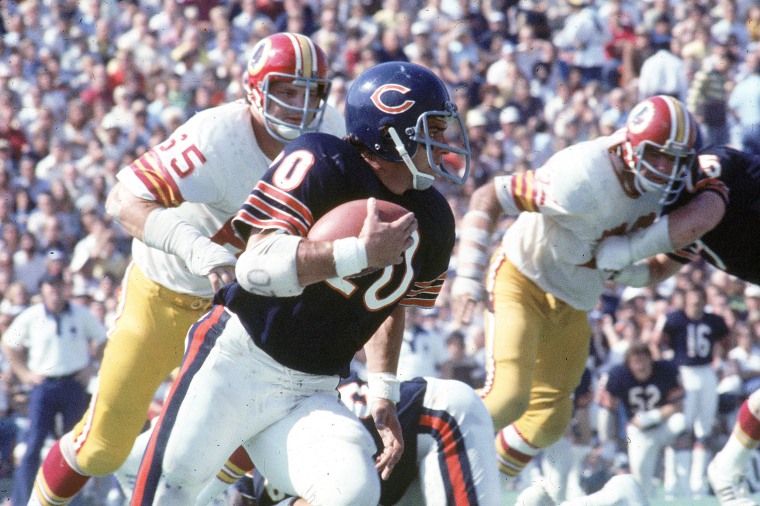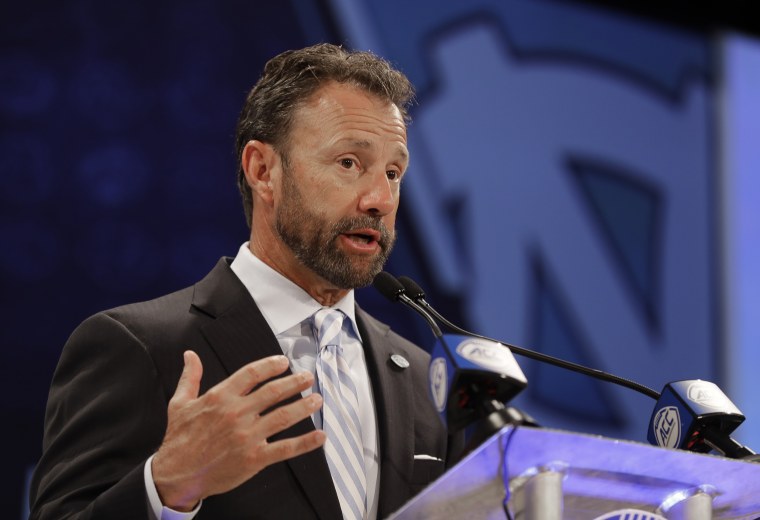For former Chicago Bears running back Mike Adamle, there is no question that football can lead to brain degeneration.
Two years ago, after nearly two decades of depression, rage and memory loss — all symptoms of chronic traumatic encephalopathy, or CTE — Adamle, 68, was told by his neurologist that he is almost certainly living with the brain disease.
The NFL acknowledges that there is a link between CTE and playing football. So do researchers. But some steadfast skeptics are still trying to muddy the science and raise questions about the connection, with a fresh wave of doubt cast this summer weeks before the season's kickoff.
"I don't think it's been proven that the game of football causes CTE. We don't really know that," Larry Fedora, the University of North Carolina's head football coach, told reporters in July. "Are there chances for concussions? Of course. There are collisions. But the game is safer than it's ever been."
Fedora has since backed down on his stance. Several weeks later, he told NBC News that his comments "did not fully express" what he believes.
"I completely understand that there is a link between CTE and football. The safety and health of our players in every aspect of the game is my biggest concern as a coach — it always has been and it always will be," Fedora said in a statement through a university spokesperson.
But a wide spectrum of people, including former players and a doctor, backed Fedora's initial position.
"I totally agree with him," Dr. Peter Cummings, a forensic pathologist and neuropathologist, said days after Fedora's remarks. "Association is not causation. CTE has also been found in individuals not exposed to contact sports. It’s not a settled matter by any means."
"I would argue that no other sport has made a more radical transformation in response to safety concerns than football." Cummings said, adding that Fedora's comments "reflect the reality of the scientific uncertainty surrounding CTE."
What is CTE?
CTE is a degenerative disease in which protein forms clumps throughout the brain, killing brain cells. Traumatic brain injuries, including concussions and repeated blows to the head, can lead to it, according to the Centers for Disease Control and Prevention. Symptoms usually don't appear until years after the blows, which don't necessarily have to be high impact. It can only be officially diagnosed after death.

Football players are not the only ones at risk for it. Anyone who sustains repetitive brain trauma — including ice hockey and soccer players, as well as war veterans and victims of domestic violence — can also develop it.
Its association with football, Americans' favorite sport to watch, according to Gallup, has been well-established. The NFL denied a direct connection for years, but finally acknowledged it in 2016 and signed a $1 billion settlement to compensate former players.
And a study last year found that the brains of 110 out of 111 former NFL players had CTE, although that research has been criticized by some, including Cummings, who argue that because the brains were donated from families who suspected that the athlete had neurological problems, the study was tainted with sampling bias. (Another study out of the University of Buffalo this month found that CTE was "more rare" than previously thought, although only 21 former players were examined for that.)
How the NFL has handled it
The NFL has taken the link seriously, making a series of safety improvements to the game, including a controversial new helmet rule instituted during the preseason, although the guidelines have been slammed as not being clear to referees and players. The NFL said last week it would consider fine-tuning ahead of the regular season, which starts next Thursday, Sept. 6.
Still, the NFL reiterated its commitment to safety in a statement to NBC News from Dr. Allen Sills, founder and co-director of the Vanderbilt Sports Concussion Center, who serves as the league's chief medical officer.
"It is clear there can be long-term health risks associated with repetitive head injuries, particularly if they are not treated properly. Close attention needs to be paid to these research findings and collectively the research community must work together to seek more answers," Sills said, adding that the focus should be on figuring out who is most susceptible to CTE.
The toll of the disease can be high. It is believed to have played a role in the suicides of numerous football players, including Junior Seau, 43; Dave Duerson, 50; Ray Easterling, 62; and Aaron Hernandez, 27, all of whom were later found to have CTE.
"CTE is very real and it poses a threat," Adamle, who played professional football from 1971 to 1976, said. "Naysayers are trying to protect the game they love, and, in fact, they're doing just the opposite. If they really cared about the game they loved, they would listen to the doctors and the players and the families that have gone through this."
"Naysayers are trying to protect the game they love and in fact, they're doing just the opposite."
The disease affects every aspect of Adamle's life, so he was not surprised when a doctor told him in 2016 after an extensive neurological exam that he was suspected of having it.
"A lot of my motor skills, things like holding onto a pen or putting my coat on, it takes me a long time to do it," said Adamle, who once took pride not only in his athletic prowess but also his ability to zip through a crossword puzzle in 10 minutes. "I read a paragraph and I have to go back and read it again because I can't remember what I read."
Current players are also re-examining their careers in the face of mounting evidence of a link to the disease. The risk was too great for Seattle Seahawks linebacker Joshua Perry, who in July announced his retirement after sustaining his sixth concussion — at age 24.
"The hard thing is you can only see the effects of CTE after somebody has passed, so there a lot of people who can deny it," Perry said. "But if you're a coach, you have to understand that players' safety should be at the forefront."
While Adamle doesn't discourage anyone from pursuing a dream in football, he urges parents to hold off putting their kids in heavy contact sports at a young age. His CTE symptoms aren't the result of one concussion, he says — but the repeated blows he sustained over the years.

And he hopes to change the culture of football so players know it's OK to bow out when they've had enough, and reach out for help if they need it. He and his wife, Kim, have partnered with Boston University’s CTE Center and the Concussion Legacy Foundation to create a support network for those who believe they suffer from the disease and their families.
"I don't think there's a single person out there who looks at this as a weakness except the players themselves," he said, adding that support from his wife and children keeps him going. "I can't imagine being all by myself and having to deal with this. It would be impossible."

